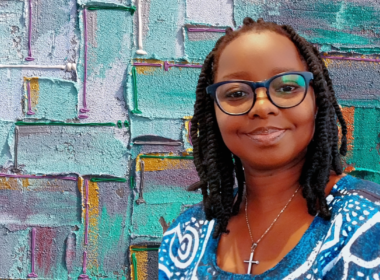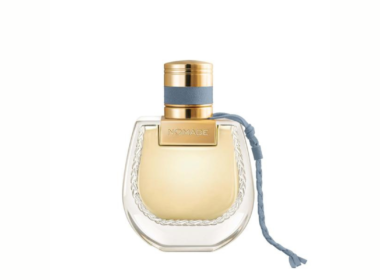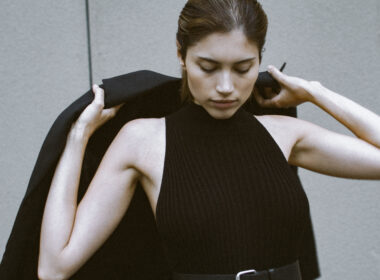There’s a certain magic in the way Gbenga Ayo-Dada approaches his craft. To hear him speak of jewellery is to hear a poet describe his muse. Gbenga Ayo-Dada, Creative Director of Gbenga Artsmith, has been a name synonymous with exceptional jewellery design for over 16 years. For many, his pieces aren’t just accessories but cherished symbols of cultural pride.
Yet, like all true visionaries, Ayo-Dada’s sights are set further still. Today, he is taking Gbenga Artsmith on a daring new path, broadening the brand beyond jewellery. The brand now includes a luxurious line of accessories, from leather bags and belts to exquisite headpieces and intricately beaded headbands. Each item, crafted with the same dedication to authenticity that has always set him apart.
This interview offers a unique reintroduction to Gbenga Ayo-Dada, not just as a jeweller but as a complete fashion accessory designer. Gbenga Artsmith is positioned to lead in the African luxury market, setting trends and crafting timeless pieces that blend traditional beauty with modern elegance. Join us as we explore the evolution of Gbenga Artsmith, its expanded focus, and Ayo-Dada’s commitment to making a mark on African fashion.
I’m not just creating fashion; I’m crafting a narrative where African luxury is celebrated for its quality, not seen as a charity case.
Gbenga Ayo-Dada
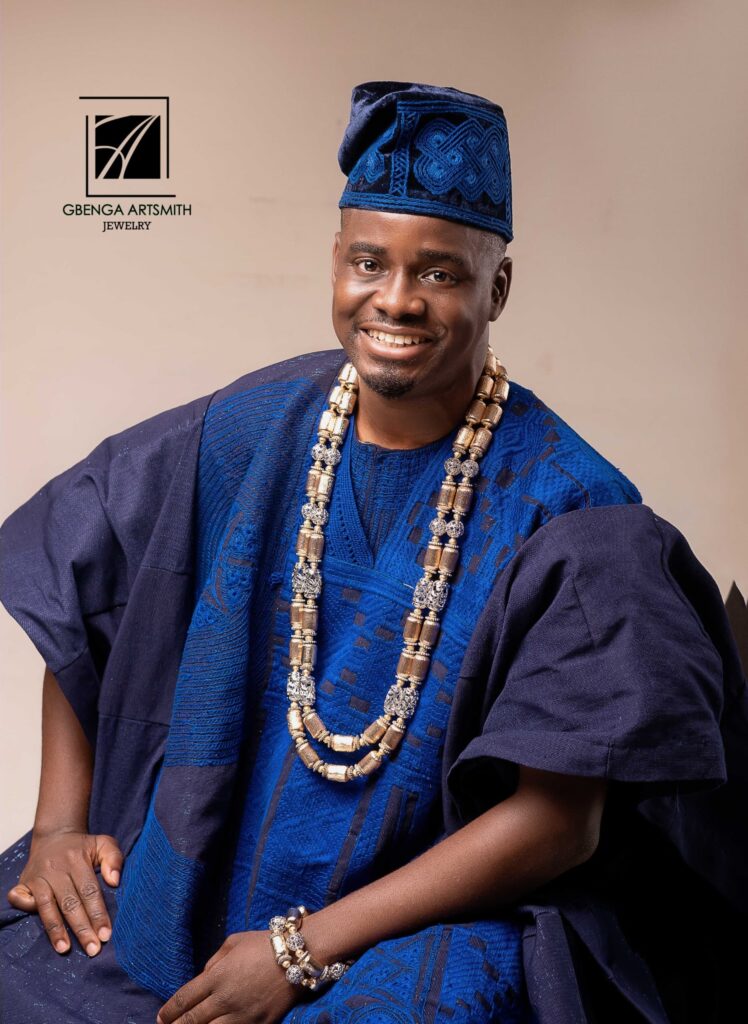
Background and Inspiration
FAB: Let’s rewind a bit and explore your journey. Sixteen years ago, when you started on your dad’s veranda, did you ever envision that your brand would grow to this level?
Gbenga Artsmith: I had an idea of what my future might hold, but I didn’t fully grasp how big it could become. I always believed I would excel and make a mark in the industry, but the extent of that success was still uncertain.
I remember, early on, experimenting with jewellery-making. I had a trance-like vision of myself on a beach, hands buried in the sand, when someone approached, touched my throat and hands, and told me my hands and voice would be used for something significant. Back then, I thought it might lead to an international music career since I also sing. Fast forward to today, and I realise that my calling is to inspire a new generation of artists and share my journey. My story motivates many, and my hands have created remarkable works of art. I’ve taught hundreds of people the craft, as well as effective business management and marketing—all using my voice to teach and my hands to create.
Yes, I had a vision, which is why the umbrella name for my brand is Arts Smith Collections. I’ll share more about how I came to that name later. Many people wonder why I didn’t simply call it something like Gbenga Beadsmith or Beadsmith Collection. From the start, I knew I wanted to go beyond just beaded jewellery; I felt that there was more in store for me. My logo has never changed, as I didn’t infuse elements of jewellery or precious stones, as I didn’t want to limit myself. I knew at some point I was going to do more than jewellery. I knew I was going to do clothing at some point and other kinds of accessories. But I just didn’t know what kind of accessories. I just knew I was going to diversify at some point. If you had asked me then, I would have told you I was most likely to diversify into clothing and not the making of bags.
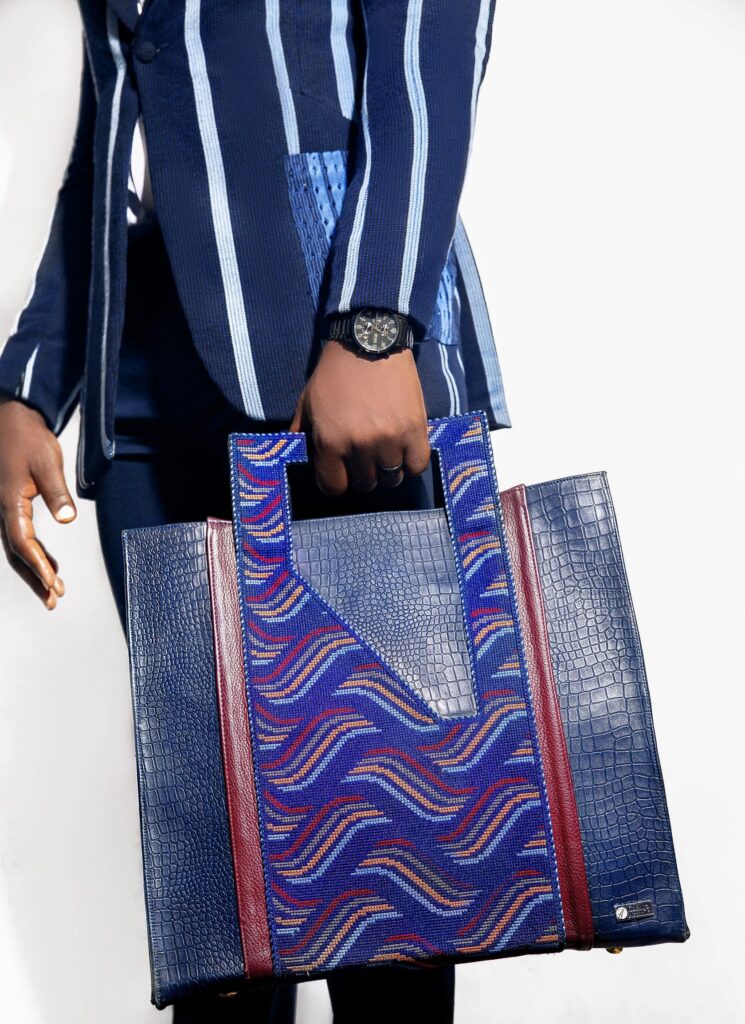
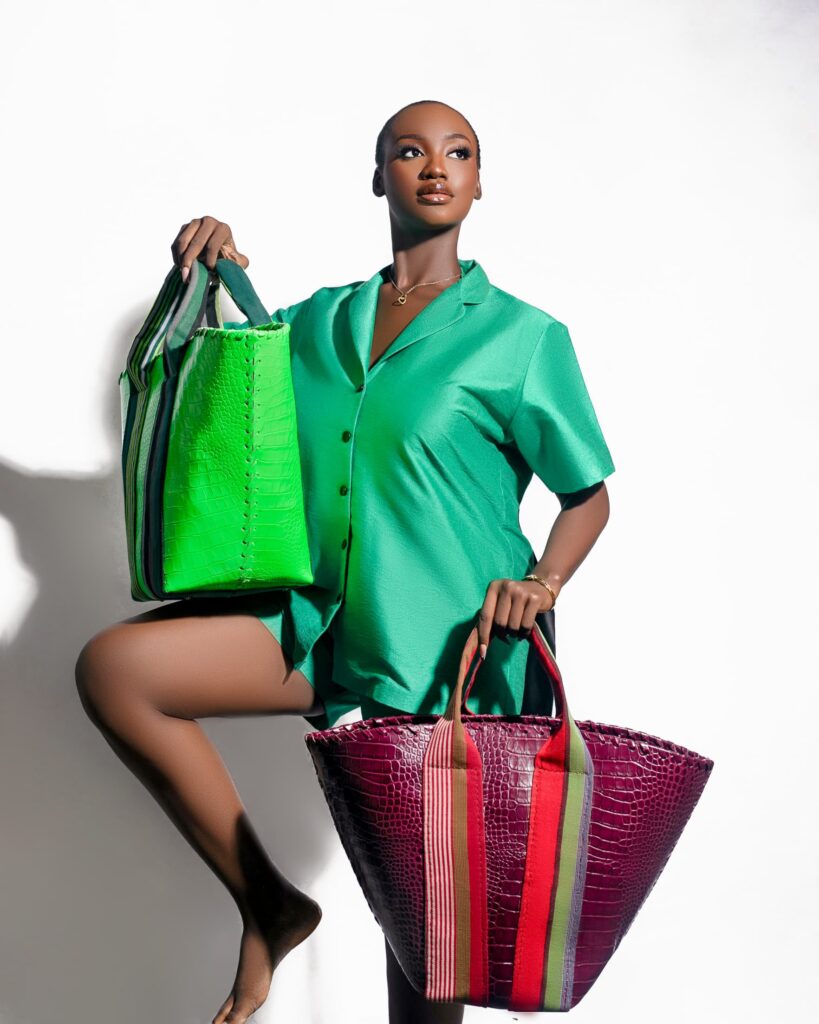
Why is Gbenga Artsmith expanding into fashion?
FAB: Recently, you exhibited your work at the African Creative Market alongside Fashion Evo, and it was a stunning presentation. After more than 16 years of being recognised as a jeweller, you’ve now expanded into other art domains. What inspired this diversification? Was it driven by market trends, or was there something deeper behind it?
Gbenga Artsmith: I’m a highly creative person, and I’ve always explored different art forms. Expanding into new outlets is simply another way for me to express myself. I’ve previously worked in textile design and creative writing; this is just one more adventure. This shift wasn’t motivated by market forecasts or demand. In fact, I ventured into clothing at one point, creating beaded tops and blouses for clients.
A pivotal moment came when a client asked me to revamp her Chanel clutch. She was tired of the bag’s rusty chain and wanted me to give it new life. That sparked an idea, and I ended up designing a fresh strap using Ankara fabric instead of leather, which I transformed into a layered necklace. I also considered a beaded strap to reflect my brand’s distinct African identity. The client loved it, and I was excited with how it turned out. This experience inspired me to experiment with adding beaded elements to clutch purses. When I shared my creations on Instagram, the response was amazing; many people asked about pricing, colour options, and sizes.
The real momentum came during the 2020 lockdown, when, like everyone, I was at home and brimming with new ideas. That rush of inspiration pushed me to turn this into a commercial venture. And here we are, four years later, still going strong.
FAB: You’ve always seen yourself on an international stage, and your work is recognised for preserving African heritage. Now, you’ve expanded your offerings beyond jewellery to include bags, wearable art, and more. Do you ever consider toning down the cultural elements to appeal to an international audience, or do you fully embrace the African influences in your work, encouraging the world to catch up?
Gbenga Artsmith: I’ve always stayed true to myself and never felt the need to compromise or pretend to be someone else. Independence has always been part of my identity, and I deeply embrace my love for African art, which I think was inspired by my childhood. Interestingly, I spent part of my early years in London, where I had a pivotal experience that shaped my outlook. One autumn, our church organised a retreat as an alternative for kids whose parents didn’t want them attending the Notting Hill Carnival. Around that time, my mom returned from Nigeria with oversized Kampala shirts for my brothers and me. I disliked them for two reasons: they were too big, and they were African. While my friends wore designer clothes, I felt embarrassed in a Kampala shirt and tried to hide it under a leather jacket.
But my mom noticed my reluctance and insisted I remove the jacket, despite my dad’s concern about the chilly weather. She wanted me to embrace my culture. I still have a photo from that day, and by the end of it, everyone loved the shirt—some even wanted to buy it, recognising its uniqueness.
This experience opened my eyes to the beauty of my heritage. What I initially saw as an embarrassment became something special for others. My mom proudly shared our background, explaining that I was Nigerian, and educated others about our culture. Many didn’t know the differences between African countries, like Nigeria and South Africa, and she helped bridge that gap.
Since then, I’ve made it my mission to tell stories about Africa through my work, emphasising the distinctions between Nigerian art and that of other African nations. I showcase the vibrancy, pride, colours, and textures of our culture. That pride has stayed with me, and now, 95% of my wardrobe consists of African designs. While I might wear foreign brands for shoes, I can’t recall owning any foreign clothing—it’s all from African designers. And here we are.
FAB: You’ve previously talked about plans to partner with international companies to expand your reach. Now that you’re diversifying your product offerings, what types of collaborations are you most interested in pursuing at this time?
Gbenga Artsmith: I’m focused on bringing my work to an international level, presenting African art with a global perspective. Currently, many people see my creations as primarily for Africans, but with the growing interest from the Western world in our fashion, we’re seeing traditional patterns like adire incorporated into materials such as silk, satin, and chiffon. I want to do the same for African jewellery and accessories by integrating them into mainstream culture.
My goal is to show people how they can incorporate these pieces into their everyday looks—whether for work or leisure. Traditionally, many in Africa have reserved these accessories for special occasions like weddings or milestone birthdays. But I believe you don’t have to wait for a special event to wear them. Perceptions are shifting; a few years ago, you’d mostly see these pieces at parties, but now people confidently wear beaded necklaces and statement bags to work.
I’ve received feedback from clients who attended various events, and they often report receiving numerous compliments and feeling more confident because of the statement their accessories make. One client even mentioned that a director recognised her jewellery and took her proposal more seriously, seeing it as a reflection of her good taste. This is the direction we’re aiming for—making these accessories part of everyday fashion, so they’re appreciated not only as African art or items for special occasions but as essential elements of daily style.


Nollywood icons Sola Sobowale and Shaffy Bello radiate elegance in Artsmith Signature Jewellery
International Recognition and CNN Feature
FAB: Your pieces have been featured at prestigious global events like London Fashion Week and Paris Fashion Week. How does that feel? And let’s be real—do you still experience nerves before the big shows?
Gbenga Artsmith: Yes, I still feel a bit of nervousness, but I’ve come a long way in managing it. In the early days, I was much more anxious, and I can tell you why: I lacked confidence in my art. I didn’t yet understand the value of my work or realise how much people loved and needed it. I hadn’t fully discovered the purpose behind my art or the demand for my pieces.
Now that I have that understanding, things have changed. If I do feel nervous before a show, it’s usually about the logistics. I might worry about the team’s readiness, whether the styling could be improved, or if the models are the right fit. I often think, “Will this model showcase the pieces the way they’re meant to be seen?” or notice small organisational issues, like a DJ error. My concern then is that these factors don’t disrupt the showcase.
So, my nerves aren’t about whether people will love the collection or how it will be received; they’re more about the presentation’s execution. Once I’m confident in the stylist and the team, any nervousness fades. Recently, the only nerves I felt were during fittings. We had challenges finding models for certain pieces, as not every item flattered every model. But we worked through those issues and ultimately had a fantastic show.
FAB: Did being featured on CNN’s African Voices change your perspective on yourself or your brand in any way?
Gbenga Artsmith: Being featured on CNN didn’t change how I view my brand. I’ve always believed in its significance, so the feature felt more like an endorsement. It showcased my brand in a new light to those who might have had doubts. When people are hesitant to shop online due to concerns about scams, this kind of recognition speaks for itself. I don’t have to defend my brand as much. Often, someone who knows the brand or someone who recommended us will step in and say, “Excuse me, do you know who he is? Do you understand?” People wouldn’t usually speak up like that if it weren’t for this kind of major endorsement. So, I’d say that’s one of the benefits I’ve gained for my brand.
But as for me, I remained pretty normal throughout the experience. When the announcement was made and people started calling me, I didn’t watch the interview until I was practically forced to. I don’t like the sound of my voice, and I don’t enjoy watching myself. While the feature did help distinguish me from other brands, I stayed grounded. When it first aired, I was just working from home, and friends were sending me screenshots of the broadcast before I had even seen it myself.
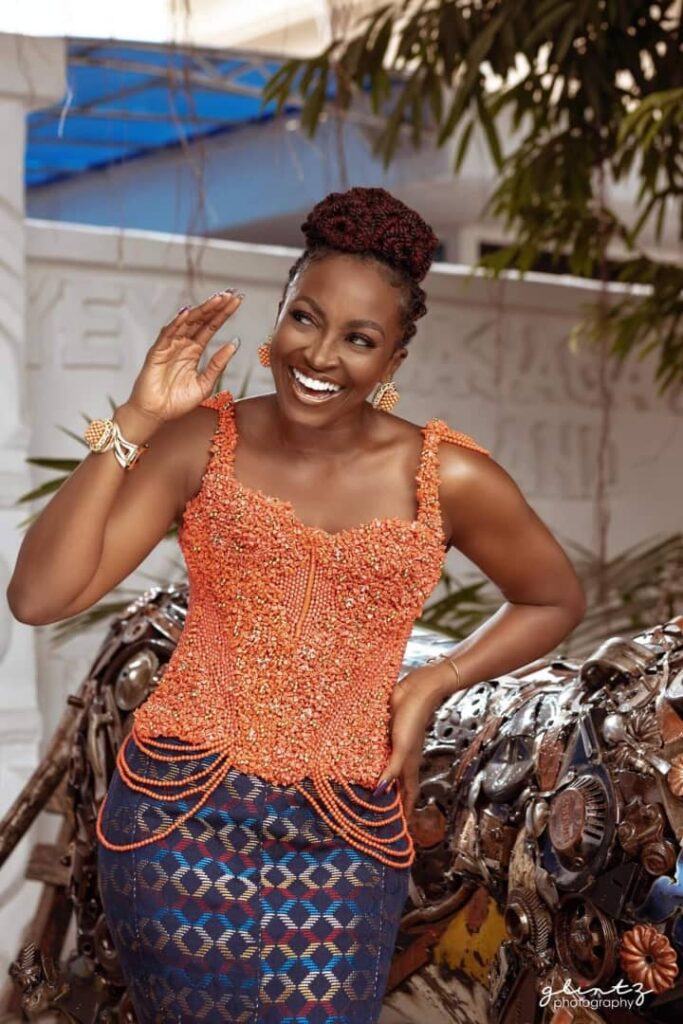
FAB: With 16 years of experience, you’ve likely witnessed a variety of trends come and go. How do you determine which trends to embrace and which to pass on?
Gbenga Artsmith: First and foremost, I don’t follow trends. I’ll say it again: I am an authentic person. I trust my instincts, and if something doesn’t resonate with me, I simply won’t do it. I’m introspective and guided by my inner voice, only engaging in projects that align with my personal values. While I run a business, I believe my values should be reflected in it, just as children carry traits from their parents, like their smile or their teeth. I want my personal values to be mirrored in my business and the projects I take on.
For example, I choose not to partner with certain celebrities. If someone has a scandalous past, I won’t collaborate with them. They’re free to buy from me and wear my pieces, but I won’t repost their images on my page. Similarly, if a client is scantily clad while holding one of my bags, I won’t share that photo either. This is why you don’t see me often posting user-generated content.
To answer your question directly: I don’t follow trends. My core philosophy has stayed the same over the years. While there have been improvements in how I craft my pieces and present my business, the Gbenga of today is still the same as the Gbenga of 16 years ago. You’ll see enhancements in my craftsmanship and business projections, but I won’t pander to current trends.
Yes, sticking to my values may have cost me opportunities and money, but I don’t mind. Trends are fleeting, but classics endure. I strive to remain a classic in a world dominated by trends.
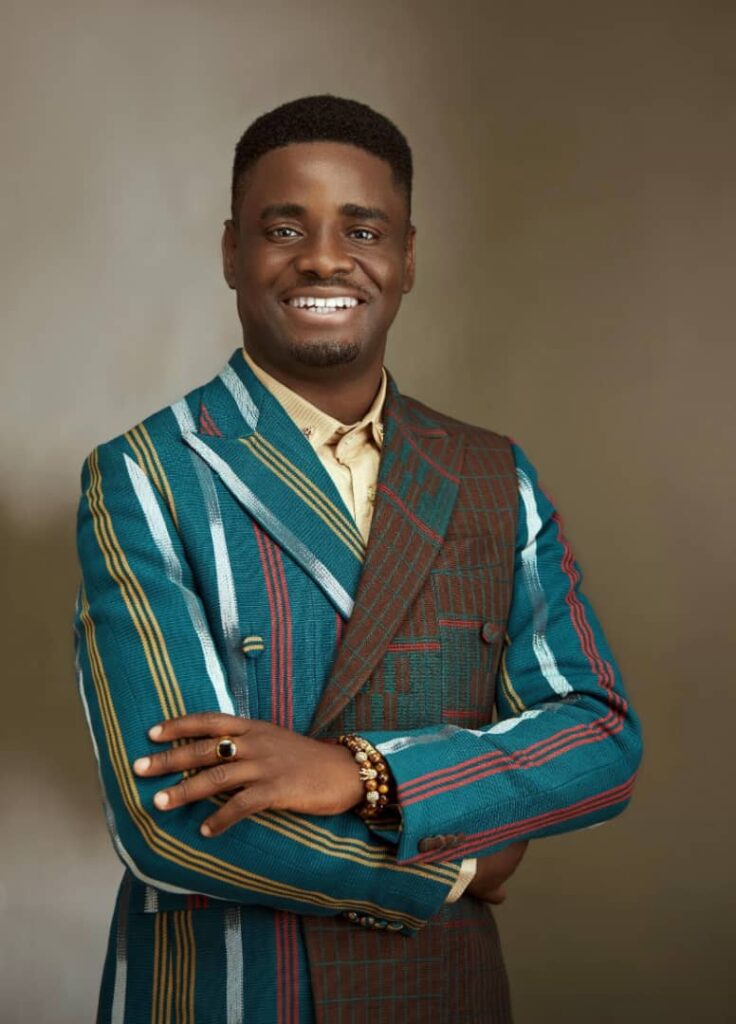
Challenges and Lessons
FAB: Can you reflect on a specific time when things didn’t go as planned? How did that experience reshape your approach moving forward?
Gbenga Artsmith: Certainly. In 2018, I launched a venture called My Old Surgery Program, inspired by an event from over ten years ago. I had created a custom pendant design that was unique to my brand. I don’t like using readily available items, as they lose my signature touch. I don’t buy pendants from craft shops or markets and leave them as they are. Instead, I take pendants, earrings, or brooches, deconstruct them, and reassemble them into something entirely new. One of my bestsellers was a pearl tassel necklace that everyone loved. Many of my colleagues even asked if they could sell it to their clients. Looking back, I admit it was a mistake to refuse them.
Unfortunately, a prominent figure in the industry, who has since passed, had all the connections, the network, and the money. She linked up with manufacturers in China, bought my pendant design through someone else, and had it mass-produced. That design has remained in the market ever since. You can imagine the hundreds of millions, maybe even billions, I could have made from it. This loss was incredibly distressing because I realised I missed a substantial profit opportunity.
This experience led to the creation of My Old Surgery Program. When I launched it, it felt like people had been waiting for it. We received a lot of inquiries, and the business started doing very well. However, we faced a challenge: we were running out of materials, particularly for our best-selling items. It was frustrating to turn customers away when they returned, saying, “My clients really love this. Can I get it again?” But the pieces were no longer available.
My business consultant suggested crowdfunding, so I posted on Instagram. There was significant interest, and I successfully raised funds to buy more inventory. This helped resolve the issue of material shortages. However, I made a critical mistake by not hiring a financial expert to manage the funds properly. I allowed emotions to guide my decisions, accepting investments from people based on sentiment, not business need. I wasn’t thinking about the returns I promised investors, which led to financial difficulties.
By 2019, I couldn’t pay the dividends. Instead of ending contracts, I kept rolling them over, hoping to extend repayment terms. Unfortunately, my business consultant, who had suggested the crowdfunding idea, was no longer around due to a falling out. I was left to handle everything alone without guidance.
Things got messy. I faced issues with my landlord at the Lekki Outlet, and the financial stress mounted. To make matters worse, an individual created a troll account on Instagram, posting defamatory content about me and threatening my peace of mind. This person spread rumours among my clients, sending private messages to high-profile clients like TY Bello, Mo Abudu, and Jumoke Adenowo. They reached out to ask, “Who is this person?” The troll was claiming I was a fraudster.
Eventually, I had to involve the police and a lawyer, who issued a cease and desist notice. The situation was chaotic. The business was heading towards bankruptcy, but somehow, we made it through. Despite all the challenges, I was able to repay everyone I owed. Some were understanding and accepted just the principal.
This experience taught me invaluable lessons. I’ve become much wiser and more intentional in my approach. I now trust my instincts more, and I realise that had I done so earlier, I could have avoided the poor advice of my former business consultant.
FAB: So, reflecting on your experiences, could you summarise three key lessons you’ve learnt from that journey?
Gbenga Artsmith: First and foremost, I’ve learnt the importance of proper planning and budgeting. I now take my finances much more seriously, which includes keeping detailed records and fully understanding my numbers. Before diving into any business venture or project, I make sure to assess all the costs involved. I always prepare for both the best and worst-case scenarios, focusing on the essentials. This means distinguishing between what I need and what I want. I prioritise the essentials and determine which tasks are urgent and which can be postponed.
Another lesson I’ve learnt is the value of having multiple backup plans—Plan B, C, and even D. While everyone talks about having a Plan B, I’ve realised that having alternatives is crucial. My team knows that I always ensure we have backup plans ready, so if one path doesn’t work out, we can quickly pivot to the next.
These are just a few of the key lessons I’ve gained from my journey, and they’ve reshaped how I approach both my business and personal growth.
FAB: You previously mentioned that jewellery was just a temporary phase for you until you went to university. Have you ever reflected on what your life might have been like if you hadn’t pursued this path?
Gbenga Artsmith: Absolutely, I’ve thought about that a lot. At one point, I explored other interests, including fashion journalism and PR, and I don’t regret those experiences. I’m confident I would have excelled in those roles and perhaps even started my own PR agency or online fashion magazine by now. However, I’ve come to realise that my true purpose lies elsewhere. While I was passionate about those fields, I wouldn’t have had the same ability to impact people’s lives or influence policies in fashion PR or journalism as I can as an accessory designer. My potential for creating change would have been more limited in those areas.
I also have the option to return to the UK, where my siblings and others are, but I often remind myself of the lifestyle I enjoy here in Nigeria. I question whether I could maintain that same lifestyle in London, and the answer is usually no. I don’t see myself fitting into a domestic routine—I’m not domesticated, and even when I have the time, I lack the patience. I prefer convenience, like taking my laundry to a laundromat. So, while I have choices, I know I wouldn’t feel as fulfilled or happy if I moved back to the UK right now. For now, I’m content with where I am.
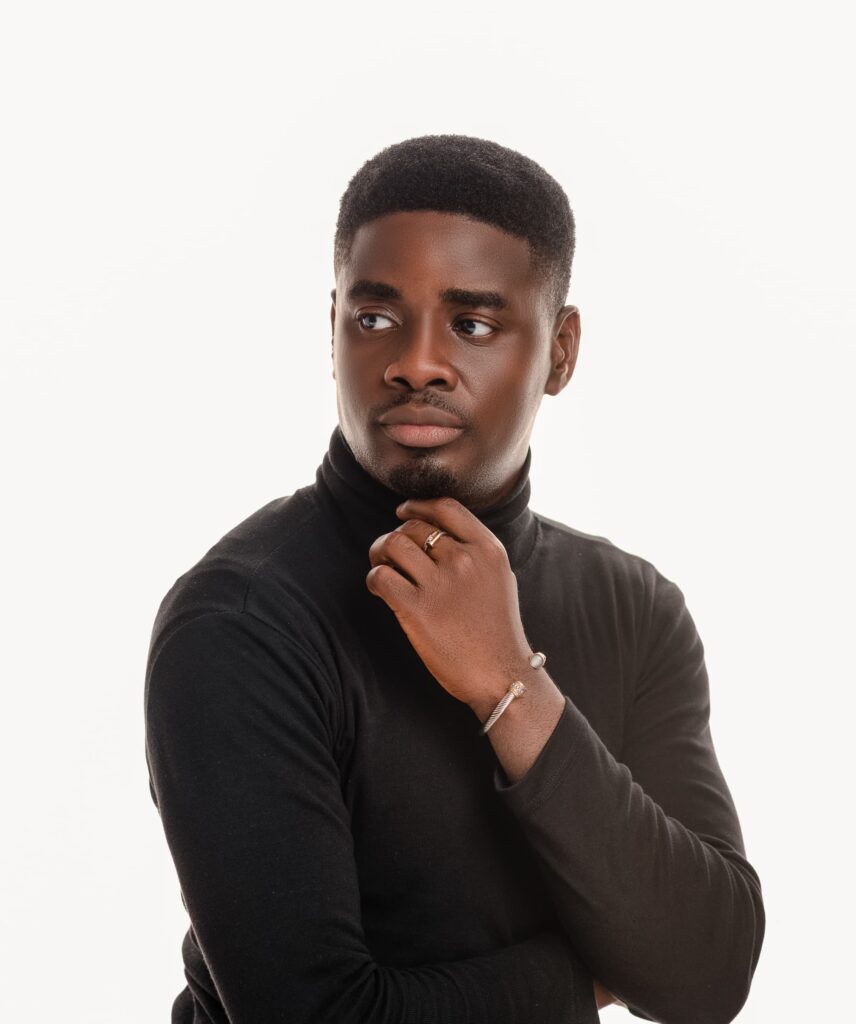
FAB: As a mentor to emerging designers, do you ever notice qualities in them that you wish you had when you first started out?
Gbenga Artsmith: Absolutely. I began this journey on a whim, fully confident in my success, but I had no idea just how successful I could become. If I had the knowledge I have now, my business would be in a much stronger position. That’s why I urge my mentees not to take their opportunities for granted. I wish I had access to someone like myself when I was starting out. Back then, the gatekeepers often wanted you to succeed but not surpass them. Many would prefer to keep you at a certain level, and when you sought mentorship, they would dismiss you or avoid you entirely.
I emphasise to my mentees that they should value the access they have to people like me, as there aren’t many who are as transparent. I may not be as big as they think, and I have my flaws and struggles. I’m open about my pains and desires, which not everyone is willing to share. That kind of openness is something I wish I had when I was starting out.
Additionally, with initiatives like the Tony Elumelu Foundation and other grant opportunities available now, I see many resources that weren’t accessible when I began. If I had those resources back then, my business would be even bigger than it is today. But I have no regrets about where I am now. I believe my purpose is to help others live better lives by sharing my experiences and mistakes, so they can learn from them. If I can accomplish that through my transparency and storytelling, then even if I didn’t achieve everything I initially wanted, I know I’m helping others reach their fullest potential, and that brings me satisfaction without regrets.
Gbenga Artsmith: I’ll begin with the Cerebral Palsy Awareness Campaign. My older brother lives with cerebral palsy, and he is truly an incredible person. Despite his disability, he excels in business, is a devoted father of two, and has a happy family life, just like anyone else. I credit my parents for this, as they were very intentional about not allowing his diagnosis to define him or us as siblings. They didn’t want us to feel burdened with the responsibility of caring for him, as that could have led to us being overly sympathetic, potentially pampering him, and making him overly dependent.
My brother often says, “I’m not disabled; I’m just abled differently.” He believes that, while he may do things his own way, he is just as capable. I’ve noticed that many families with children who have disabilities often place caregiving responsibilities on older siblings, which can rob those children of their childhood and force them into the role of a parent at a very young age. There’s also the issue of stigmatization. Despite progress in awareness, challenges remain—such as the lack of priority seating on public transport. Things like priority entrances and wheelchair ramps at hospitals and malls weren’t common before, but now they are.
When I began my advocacy, it was essential to push for inclusion. My brother attended regular schools and graduated from Babcock University with a degree in International Law and Diplomacy, never feeling less capable or that something was wrong with him because of his disability. This experience inspired me to help other children and families, and that’s what led me to launch my first awareness campaign, the Disabled Policy Awareness Campaign, in 2018.
The campaign featured well-known singer Kuchi Kuchi Judy, whose child also lives with cerebral palsy. I produced a documentary about my brother’s journey, along with the stories of another advocate. Together, they shared their experiences from different perspectives—whether as a carer, a person living with a disability, or an advocate. The campaign was a success, receiving tremendous support, including from celebrities like Omowunmi.
Next, I turned my focus to the Breast Cancer Awareness Campaign, which was inspired by my mother’s friend, who tragically passed away from the disease. She was childless, and in Africa, a childless woman often faces additional stigma. She suffered in silence, and by the time anyone realised she was battling breast cancer, it was too late. This lack of awareness and the stigma around it deeply impacted me.
Her story sparked my advocacy for breast cancer awareness, emphasising the importance of self-examinations and regular mammograms. It was about education, raising funds for patient navigators, and supporting underprivileged people battling breast cancer. This campaign also received significant media attention and goodwill, particularly from the press. It ultimately led to my feature on CNN African Voices, further amplifying the message.
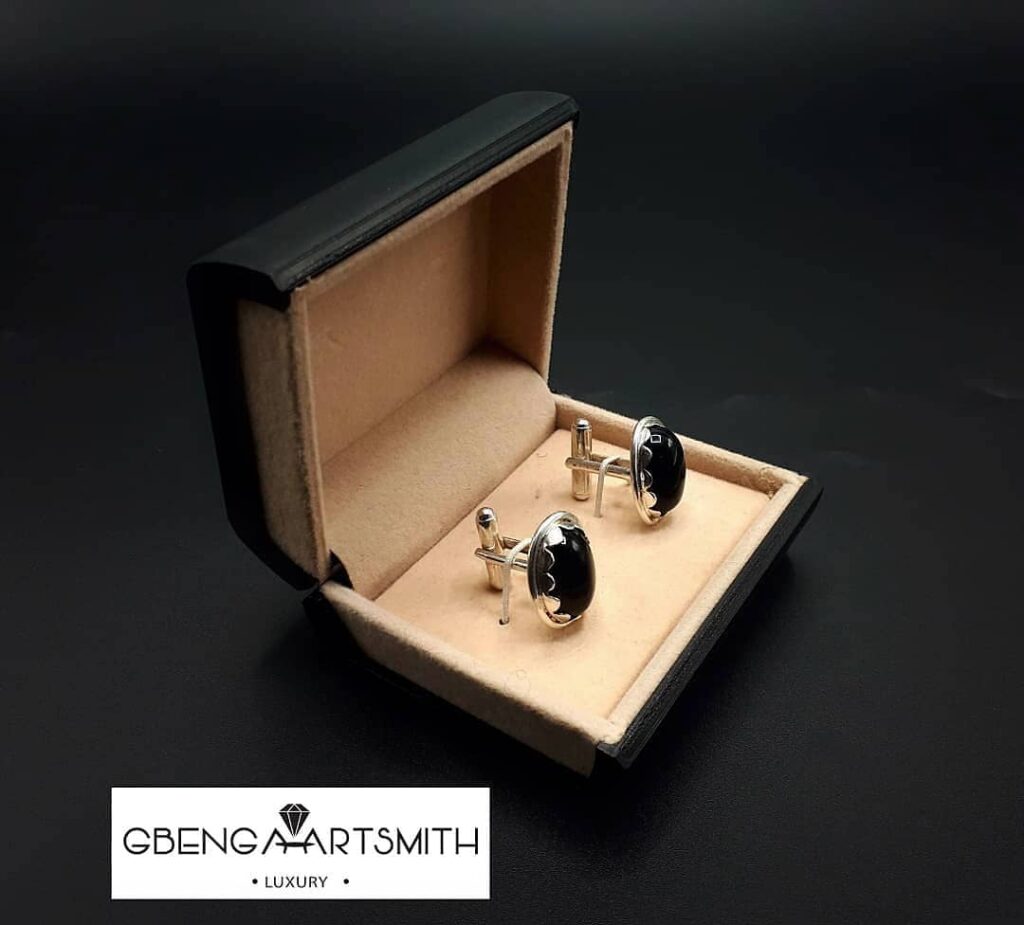
Vision for the Future and Legacy
FAB: Now, on a lighter note, if you could design a piece for anyone, living or deceased, who would it be and what would you create?
Gbenga Artsmith: It would have to be my favourite singer of all time, Whitney Houston. I’ve always envisioned designing a headpiece for her rather than jewellery. I think it’s because I’m so captivated by the headpiece she wore on her wedding day and during her 1992 concert tour. Whenever I think of Whitney, those headpieces inspire my designs. So if given the chance, I would definitely create something for her.
FAB: Are there any new materials or techniques that you’re eager to explore in your upcoming collections?
Gbenga Artsmith: Definitely! I’m looking to experiment with resin and create some acrylic pieces. I’m particularly excited about making resin jewellery. That’s the main material I want to explore further.
FAB: To wrap things up, what can we expect from your upcoming expansion in your jewellery line in 2025?
Gbenga Artsmith: In 2025, you can definitely expect to see more leather goods from us—new designs of our existing leather bags, belts, and, of course, more jewellery, but you would see more of our leather bags and leather belts.
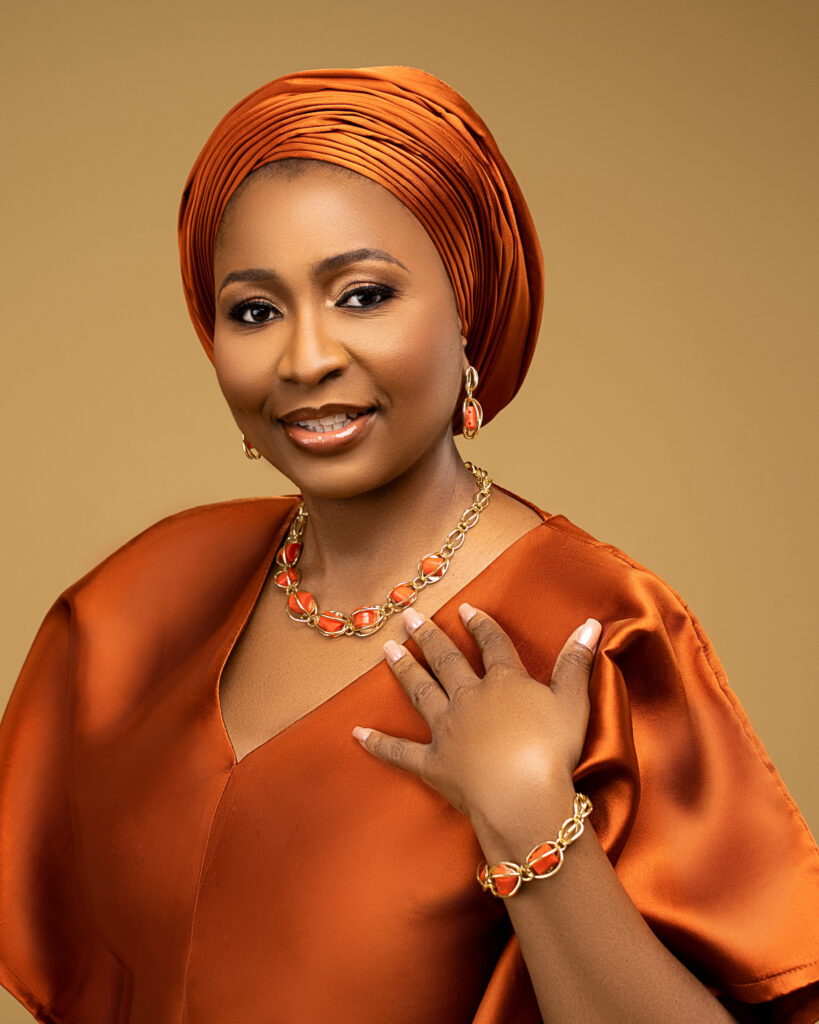
Why Gbenga Artsmith Believes Desperation is Killing Nigerian Entrepreneurs
FAB: What are your thoughts on globalisation and the growing interest in African luxury products. Some people view this trend as merely exotic or as part of a poverty alleviation initiative. How can African designers and creatives shift this narrative to emphasise that their products are not just about elevating poverty but rather about high-quality, desirable goods that stand on their own merit?
Gbenga Artsmith: I mentor Nigerian entrepreneurs through a WhatsApp group, and one key lesson I always share is the importance of avoiding desperation. When clients sense desperation, even if they can afford your products and recognise their value, they may second-guess your abilities and try to short-change you. For example, if you price your product at 25,000 but it’s actually worth 50,000, desperation can lead them to negotiate it down to 15,000. I stress the importance of believing in the value of your jewellery from the start.
Earlier this year, I hosted a webinar where I discussed the value of jewellery. I encouraged participants to view jewellery not as an afterthought, but as a vital part of self-expression and a confidence booster. Jewellery plays an essential role in enhancing one’s appearance and can transform an outfit. For instance, long jewellery can create the illusion of a longer torso, just as heels can make someone appear taller. Jewellery elevates a look.
When entrepreneurs understand these aspects, it helps them present themselves confidently and turn down offers that don’t reflect the value of their work. Sometimes, you may encounter clients who are condescending. In such cases, it’s okay to say no, as it’s more empowering to decline a job than to accept one that undervalues your worth.
If you undervalue yourself, so will the world. Confidence in your craft is the first step to commanding respect.
Gbenga Ayo-Dada
What I’m doing now isn’t empowerment in the traditional sense. I’m helping others recognise the power they already have—the power to transform raw materials into finished products. I want them to embrace this power and express it through their marketing, messaging, and branding. It’s essential to avoid any branding that comes off as desperate.
There’s a trend among some Nigerian business coaches advocating for emotional marketing, where they plead for sales by sharing their hardships. This approach only breeds scepticism, as it makes potential clients question your trustworthiness. I’m teaching aspiring entrepreneurs to see themselves as powerful, so they don’t let anyone belittle them or make them feel like they’re doing a favour by purchasing their products.
I no longer tolerate that kind of behaviour. If someone treats me that way, it reflects their ignorance of my brand. I respond confidently, which may initially come across as arrogance, but it’s really just confidence. If someone tries to negotiate disrespectfully, I may let them know we can’t fulfil their order at that time. In the end, they usually return, realising the mistake they made in how they approached me. The key is to never allow yourself to be treated like a doormat.
What Whitney Houston Taught Gbenga Artsmith About Legacy and Mentorship
FAB: Imagine it’s 200 years from now, and your legacy is remembered, like Shakespeare or even Whitney Houston, whom we just spoke about. What do you want people to remember you for?
Gbenga Artsmith: I want to be remembered as someone who was deeply resourceful and genuinely helpful—a person who truly made life better for others, whether through material support or simply by inspiring them with how I lived. Whitney Houston, for example, wasn’t just celebrated as one of the greatest singers; she was also known for nurturing talent, fostering gifts, and inspiring others. Look at artists like Deborah Cox, Brandy, and Monica—Whitney’s influence on them is clear. She mentored them, offering guidance and a platform when they doubted themselves.
For the Waiting to Exhale soundtrack, I’ve heard that Whitney personally chose the singers. She insisted on selecting artists with unique voices who might have been overlooked otherwise. She picked talents like Mary J. Blige, giving women without a platform the chance they deserved. On songs like “Heartbreak Hotel,” she included emerging voices like Kelly Price and Faith Evans, helping them break through when they were still relatively unknown. Whitney not only put them on an iconic track, but also ensured they recorded an unforgettable music video, elevating them through such a memorable collaboration.
Even years after her passing, people still talk about Whitney’s music and her lasting impact on those around her. That’s the kind of legacy I want to leave—a legacy where people remember my contributions to the industry, my innovative designs, and how I helped uplift others in meaningful ways. Even the Queen of Soul, Aretha Franklin, is remembered not just for her incredible talent, but for her sharp tongue and often abrasive nature. I don’t want that to be how people remember me. I want them to remember me for the difference I made in their lives, not just for my talent or designs.
I hope that when people reflect on their success, they’ll say, “If not for Gbenga, I wouldn’t be where I am today. He taught me that business skill, opened my eyes to new sales channels, and showed me the value of excellent customer service.”
This is about giving people something that lasts longer than jewellery—a gift of knowledge, insight, and inspiration that they can pass on, teach others, and share with everyone who sees their work. At some point, I may no longer be able to create jewellery, but the wisdom I’ve shared and the principles I’ve instilled will live on and multiply. So, beyond my artistry, I want to be remembered for the impact I made and for the person I was.
FAB: You want to be remembered for your person above your art, that there is a human behind the brand.
Gbenga Artsmith: Exactly.
#FunZone: FABFastFive
FAB: If you could only dress in one colour for the rest of your life, what would it be?
Gbenga Artsmith: Blue.
FAB: If you could be any household item, what would you be?
Gbenga Artsmith: Spoon, it’s very versatile.
FAB: If you had a time machine, would you travel to the future or back to the past?
Gbenga Artsmith: Back to the past.
FAB: If you could choose one song to play every time you walked into a room, what would it be?
Gbenga Artsmith: Let me just choose one that I always sing, To God Be the Glory.
FAB: if you had to work and you did not need the money, what kind of work would you do?
Gbenga Artsmith: What I’m doing right now.
All Images: Courtesy of Gbenga Artsmith
